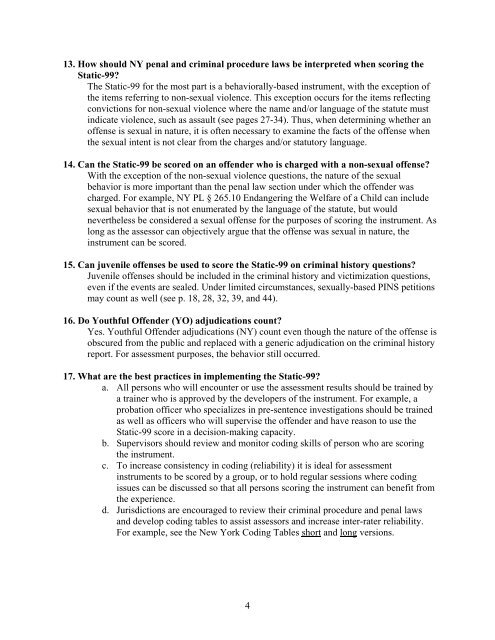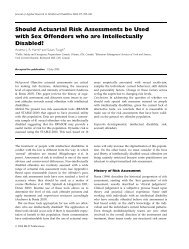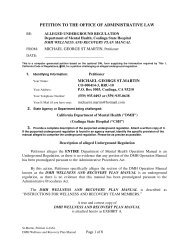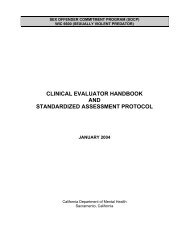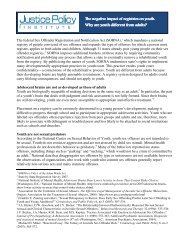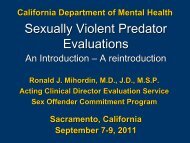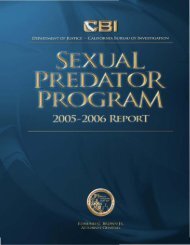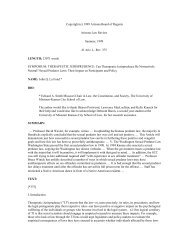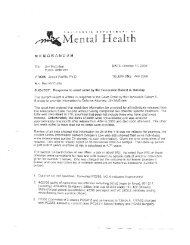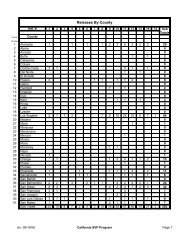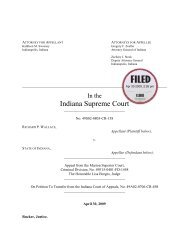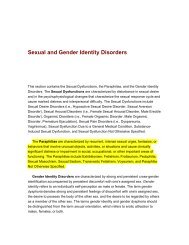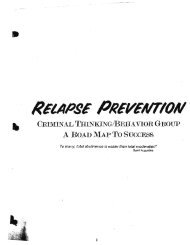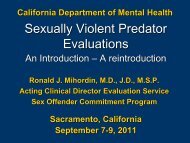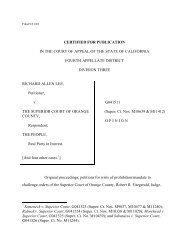Static-99 FAQ - Defense for SVP
Static-99 FAQ - Defense for SVP
Static-99 FAQ - Defense for SVP
Create successful ePaper yourself
Turn your PDF publications into a flip-book with our unique Google optimized e-Paper software.
13. How should NY penal and criminal procedure laws be interpreted when scoring the<br />
<strong>Static</strong>-<strong>99</strong><br />
The <strong>Static</strong>-<strong>99</strong> <strong>for</strong> the most part is a behaviorally-based instrument, with the exception of<br />
the items referring to non-sexual violence. This exception occurs <strong>for</strong> the items reflecting<br />
convictions <strong>for</strong> non-sexual violence where the name and/or language of the statute must<br />
indicate violence, such as assault (see pages 27-34). Thus, when determining whether an<br />
offense is sexual in nature, it is often necessary to examine the facts of the offense when<br />
the sexual intent is not clear from the charges and/or statutory language.<br />
14. Can the <strong>Static</strong>-<strong>99</strong> be scored on an offender who is charged with a non-sexual offense<br />
With the exception of the non-sexual violence questions, the nature of the sexual<br />
behavior is more important than the penal law section under which the offender was<br />
charged. For example, NY PL § 265.10 Endangering the Welfare of a Child can include<br />
sexual behavior that is not enumerated by the language of the statute, but would<br />
nevertheless be considered a sexual offense <strong>for</strong> the purposes of scoring the instrument. As<br />
long as the assessor can objectively argue that the offense was sexual in nature, the<br />
instrument can be scored.<br />
15. Can juvenile offenses be used to score the <strong>Static</strong>-<strong>99</strong> on criminal history questions<br />
Juvenile offenses should be included in the criminal history and victimization questions,<br />
even if the events are sealed. Under limited circumstances, sexually-based PINS petitions<br />
may count as well (see p. 18, 28, 32, 39, and 44).<br />
16. Do Youthful Offender (YO) adjudications count<br />
Yes. Youthful Offender adjudications (NY) count even though the nature of the offense is<br />
obscured from the public and replaced with a generic adjudication on the criminal history<br />
report. For assessment purposes, the behavior still occurred.<br />
17. What are the best practices in implementing the <strong>Static</strong>-<strong>99</strong><br />
a. All persons who will encounter or use the assessment results should be trained by<br />
a trainer who is approved by the developers of the instrument. For example, a<br />
probation officer who specializes in pre-sentence investigations should be trained<br />
as well as officers who will supervise the offender and have reason to use the<br />
<strong>Static</strong>-<strong>99</strong> score in a decision-making capacity.<br />
b. Supervisors should review and monitor coding skills of person who are scoring<br />
the instrument.<br />
c. To increase consistency in coding (reliability) it is ideal <strong>for</strong> assessment<br />
instruments to be scored by a group, or to hold regular sessions where coding<br />
issues can be discussed so that all persons scoring the instrument can benefit from<br />
the experience.<br />
d. Jurisdictions are encouraged to review their criminal procedure and penal laws<br />
and develop coding tables to assist assessors and increase inter-rater reliability.<br />
For example, see the New York Coding Tables short and long versions.<br />
4


